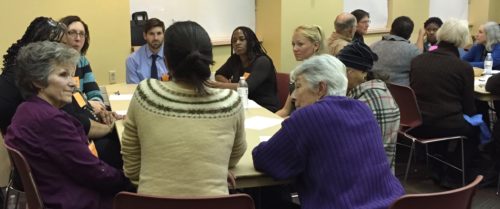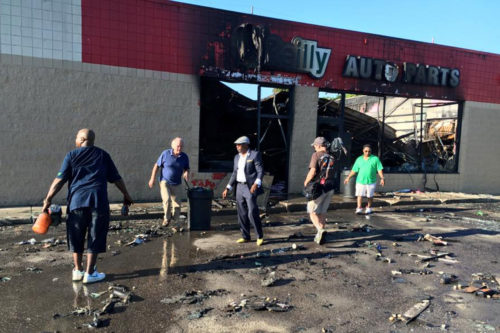Our Museum’s Response to Milwaukee’s Recent Unrest
Share
Explore Our Galleries
Breaking News!
Today's news and culture by Black and other reporters in the Black and mainstream media.
Ways to Support ABHM?
Because America’s Black Holocaust Museum (ABHM) is based in Milwaukee, Wisconsin, visitors to ABHM online have inquired about our response to the recent unrest in a predominantly black neighborhood in our city. Though not immediately apparent on the ABHM website, our museum’s principal spokesperson has been helping local, national, and international press explain these events by supplying interviews and articles. (See links to several of these below.)

Maria Cunningham, ABHM facilitator (center), listens intently to a group member during “Hidden History,” ABHM’s 2015 film/dialogue series.
For twenty-eight years, ABHM has provided a safe place where people of all backgrounds can learn about America’s racial history and talk straightforwardly about race and racism. Online, our museum tells many of the stories seldom told in American history books and documents how that history affects our society today. Offline, we present frequent talks and facilitate interracial dialogs in this community and beyond.

The morning after angry youth burned several businesses following the police killing of a young black man, neighbor residents came out to clean up.
When a group of young people took out their anger and frustrations with local policing and poverty by setting fire to a police car and three businesses, many people seemed surprised. We were not. This was a combustible situation. That car and those establishments represented the complex set of debilitating conditions that have hurt Milwaukee’s African American community for generations. During the 1960’s struggle for civil rights here, there were calls to find remedies for institutional discrimination. Fifty years later, those remedies remain largely unimplemented.
The UN General Assembly proclaimed 2015-2024 as the International Decade for People of African Descent with the goal of achieving “recognition, justice and development.” Can we achieve these in the USA? We believe that ABHM can be part of the solution.

Dr. James Cameron, lynching survivor, addresses US Senators and descendants of lynching victims, Washington DC, 2005.
Our museum’s founder, Dr. James Cameron, worked all his life to educate Americans about the ways that ongoing racial injustice prevents America from living up to its stated ideals of liberty and justice for all. Despite being lynched as a teenager, he always dreamed that Americans would come together to form “one single and sacred nationality.”
ABHM is a Site of Conscience, member of a coalition of memorial museums and sites in active and post-conflict zones around the world. As such, we help our compatriots understand how America’s racial history affects our country today and how, together, we can create a bright and fair tomorrow for all America’s children.
If you would like to further understand the issues that sparked the fires of August 13, 2016, please follow links below – and then explore seldom-told stories in American history in ABHM’s galleries.

Residents protest the decades of disinvestment and joblessness in the Sherman Park area that ignited the recent turmoil.
“Milwaukee Shooting: Curfew Imposed in Hopes of Restoring Calm” by Madison Park, Holly Yan and Ray Sanchez, CNN
“Evidence of Things Unknown” by Reggie Jackson, Milwaukee Independent
“Complex Issues Contributed to Recent Milwaukee Unrest” – Central Time Show on Wisconsin Public – Radio Interview with ABHM Head Griot Reggie Jackson
“What It’s Like to Be Black in Milwaukee” by Ray Sanchez, CNN
“After decades of segregation, anger boils over in Milwaukee” by Brendan O’Brien, Reuters
“Why Sherman Park Media Coverage Was Out of Focus” by Reggie Jackson, Milwaukee Independent
“Community Leaders Reject WEDC’s Jobs Claims for Sherman Park Area” by Matthew Brusky, Milwaukee Independent
“Teenage girl stands as park peacemaker despite any tensions” by Shateria Wiley, YouthRise Milwaukee









Comments Are Welcome
Note: We moderate submissions in order to create a space for meaningful dialogue, a space where museum visitors – adults and youth –– can exchange informed, thoughtful, and relevant comments that add value to our exhibits.
Racial slurs, personal attacks, obscenity, profanity, and SHOUTING do not meet the above standard. Such comments are posted in the exhibit Hateful Speech. Commercial promotions, impersonations, and incoherent comments likewise fail to meet our goals, so will not be posted. Submissions longer than 120 words will be shortened.
See our full Comments Policy here.